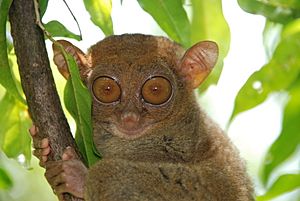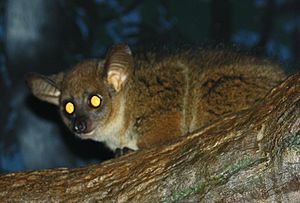Prosimian facts for kids
Quick facts for kids Prosimian |
|
|---|---|
 |
|
| Tarsiers are prosimian primates, but more closely related to monkeys, apes, and humans (simians) than to other prosimians. | |
| Scientific classification | |
| Kingdom: | |
| Phylum: | |
| Class: | |
| Order: | |
| Suborder: |
Prosimii not used in
formal taxonomy) Illiger, 1811
|
Prosimians are a group of primates. This group includes all living and extinct strepsirrhines. Examples are lemurs and lorises. It also includes haplorhine tarsiers and their extinct relatives. Basically, prosimians are all primates except for monkeys, apes, and humans.
Scientists consider prosimians to have more "primitive" traits. This means they have older features compared to monkeys, apes, and humans. Monkeys, apes, and humans are called simians.
Simians developed from within the prosimian group. They are closely related to tarsiers. Because of this, the term "prosimian" is not often used in modern taxonomy. This is because it does not group animals by their closest relatives. However, the term is still useful. It helps explain how tarsiers behave compared to other primates.
Prosimians are the only primates naturally found in Madagascar. They also live across Africa and in Asia.
Contents
Amazing Prosimian Traits

Prosimians share many interesting features. These traits are often found in other mammals, not just primates. Their diets usually include less fruit than simians. Many prosimians hunt insects and small animals in trees. They are active predators.
Most prosimians outside Madagascar are nocturnal. This means they are active at night. This helps them avoid competing directly with simian primates. Only a few simians, like the owl monkeys, are nocturnal.
Night Vision and Color
Because they are often nocturnal, prosimians do not see colors as well as monkeys, apes, and humans. Like most placental mammals, they have trouble telling red and green apart. This allows their eyes to have more rod cells. Rod cells help them see better in low light.
Many prosimians also have a special reflective layer behind their retina. It is called a tapetum lucidum. This layer reflects light that passes through the retina. It helps their photoreceptors get more light. This is like what you see in cats' eyes at night. However, this layer is not as strong in prosimians that are active during the day.
Special Grooming Claws
All prosimians have two flattened toilet claws. They use these claws for grooming themselves. Lemurs and lorises have these claws on their second toe. Tarsiers have them on their second and third toes. Aye-ayes have claws on almost all their fingers and toes. This includes a toilet claw on their second toe. Some small New World monkeys also have claw-like nails, but they do not have a toilet claw.
Reproduction and Offspring
Prosimians have a bicornuate uterus. This means their uterus has two separate chambers. In simians, these chambers are joined together. This is rare in other mammals. Prosimians usually give birth to more than one baby at a time. Monkeys, apes, and humans usually have only one baby at a time.
Brain Size and Social Life
Primates are known for being smart. But prosimians do not have very large brains compared to other mammals. Their skulls are much smaller than simians of the same size. For example, in tarsiers, one eye weighs about the same as their whole brain!
Prosimians generally show simpler thinking abilities. They also live in simpler social groups than simians. The most social prosimians are the lemurs that are active during the day. They can live in groups of up to 20 individuals. Prosimians that are active at night usually live alone.
See also
 In Spanish: Prosimii para niños
In Spanish: Prosimii para niños

